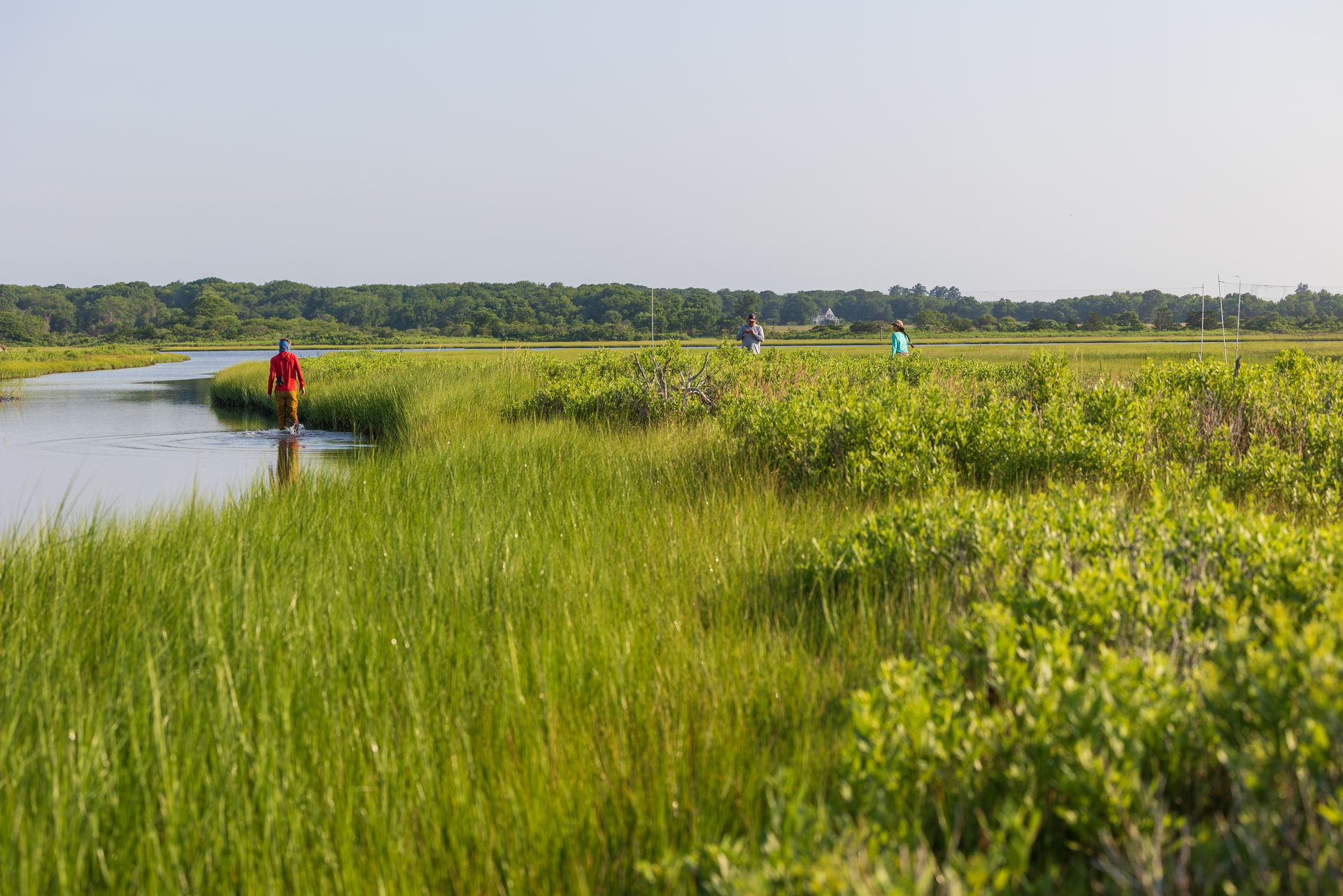Ecological Restoration
Ecological Restoration of Salt Marshes
Did you know that Massachusetts has more salt marshes than any other state in the northeast? Salt marshes are biologically-rich natural communities that exist between the high tide and low tide line in places with low wave energy.
The plants that live in salt marshes have adapted to daily tides and saltwater exposure. Massachusetts coastal communities depend on salt marshes for storm protection, pollution filtering, and habitat for many birds, fish, and other wildlife. Most of Massachusetts' carbon storage comes from salt marshes.
Unfortunately, over the past century we’ve lost over 40% of our original salt marshes to human development, sea level rise, and other impacts. Thanks to recent scientific discoveries, we now better understand how past actions—such as agricultural ditches and embankments —continue to harm modern salt marshes. Ecological restoration can help heal past damage and prepare salt marshes to withstand climate change and continue to thrive into the future.
Current Salt Marsh Restoration Projects
Barnstable Great Marsh Restoration
- Summary: The site is degraded by ditches and embankments from historical agricultural activities which alter tidal flows and promote loss of marsh peat and vegetation. Restoration actions will restore more natural hydrology by closing old ditches and creating new drainage features.
- Status: The project is currently in the restoration design phase.
- Location: Barnstable, Mass Audubon’s Barnstable Great Marsh Wildlife Sanctuary
- Our Role: Project management and on-going stewardship
- Partners: Association to Preserve Cape Cod, MA Department of Fish and Game In-lieu Fee Program, US Fish and Wildlife Service, National Fish and Wildlife Foundation, private donors, Northeast Wetlands Restoration, and EA Engineering.
- Acres: 78 to be restored
- Barriers: 0
- Other benefits: Showcase emerging methods for salt marsh restoration on Cape Cod and provide an example for others considering this work locally. Improve nesting areas for saltmarsh sparrows.
Wellfleet Bay Salt Marsh Restoration
- Summary: The site is impacted by numerous stressors including ditching, crab herbivory, and tidal restrictions. Restoration actions will restore natural hydrology and improve marsh conditions by removing a tidal restriction at Goose Pond, closing select ditches and piloting a technique of sediment placement to increase elevation and encourage revegetation.
- Status: The project is currently in the engineering design phase as of January 2025.
- Location: Eastham, Mass Audubon’s Wellfleet Bay Wildlife Sanctuary
- Our role: Project management and on-going stewardship
- Partners: MA Division of Ecological Restoration, U.S. Fish and Wildlife Service, National Fish and Wildlife Foundation, EA Engineering, Friends of Herring River
- Acres: 141 to be restored
- Barriers (dams, culverts): 1 tidal restriction removed at Goose Pond, with 3 more potential barriers to be removed in the future
- Other benefits: Pilot sediment placement as a restoration method in Massachusetts using new state guidance and permitting processes.
Cape Cod Salt Marsh Initiative
- Summary: This initiative will increase coastal resiliency by building capacity in three Cape Cod towns (Barnstable, Dennis, and Eastham) with Environmental Justice communities to conduct ecological restoration work. Efforts include feasibility assessments of a salt marsh restoration site in each community, developing salt marsh permitting guidance, developing a demonstration management and monitoring plan, and offering site visits to Barnstable Great Marsh and Wellfleet Bay restoration sites.
- Location: Cape Cod
- Our role: Project manager
- Partners: U.S. Fish and Wildlife Service, Waquoit Bay National Estuarine Research Reserve, National Fish and Wildlife Foundation, Towns of Eastham, Dennis, and Barnstable
- Other benefits: This project also establishes the Cape and Islands Restoration Action Team (CIRATs), a collaborative of partners working on salt marsh restoration across Cape Cod and the Islands. The CIRATs will be provided training as a SMARTeam Field Team, empowering them to evaluate and design salt marsh restoration projects.
Allens Pond Salt Marsh Restoration
- Summary: This wildlife sanctuary includes hundreds of acres of beach, fields, woodlands, pond, salt marsh, and scenic trail systems. Salt marshes on site are degraded due to historic farming practices and landscape alterations. Restoration actions are underway to restore more natural hydrology by removing tidal restrictions, removing debris and invasive plant barriers, and digging shallow channels to allow for better drainage of areas at risk of flooding. Significant invasive species (Phragmites australis, Common Reed) removal and management actions have helped facilitate successful revegetation by native plants.
- Location: South Dartmouth, Mass Audubon's Allens Pond Wildlife Sanctuary
- Our role: Project management, on-the-ground implementation, on-going stewardship
- Partners: U.S. Environmental Protection Agency Southeast New England Program, Save the Bay, Dartmouth Natural Resource Trust, Bristol Country Mosquito Control District, private foundation funders.
- Acres: 40-acres of marsh restored and an additional 90-acres in progress
- Barriers (dams, culverts): Multiple small barriers to inland marsh migration removal (e.g., stone walls, small water control structures)
- Other benefits: Improved Saltmarsh Sparrow habitat and intensive biological monitoring.
Rough Meadows Salt Marsh Restoration
- Summary: This site is currently under stress due to legacy farming features and sea level rise, resulting in vegetation die-off, bare depressions, and pooling water on the marsh surface. Restoration actions will restore natural hydrology by removing barriers, filling select agricultural ditches, creating shallow drainage channels (“runnels”). These actions will provide revegetation and increase climate change resiliency.
- Status: The project is in the restoration design phase as of October 2023.
- Location: Rowley/Mass Audubon's Rough Meadows Wildlife Sanctuary
- Our Role: Project management
- Partners: Greenbelt, MassWildlife, In-Lieu Fee Program, and SMARTeam
- Acres: 168 to be restored
- Barriers (dams, culverts): 1 culvert blocking tides to be removed
- Other benefits: Promote future inland marsh migration. Create habitat for species such as the common tern and Saltmarsh Sparrow
Great Marsh Restoration
- Summary: Mass Audubon is helping to implement on-the-ground restoration at the US Fish and Wildlife Service’s Parker River National Wildlife Refuge, part of the Great Marsh on the North Shore of Massachusetts. Salt marsh restoration techniques include restoring natural hydrology by ditch remediation and digging shallow channels “runneling” as well as the creation of small bird nesting knolls.
- Location: Newburyport, Parker River National Wildlife Refuge
- Our role: Leading on-the-ground restoration work
- Partners: US Fish and Wildlife Service, Ducks Unlimited
- Acres: 1,450 of salt marsh to be restored
- Barriers (dams, culverts): 0
- Other benefits: Improved health and resilience of the Great Marsh. Enhanced habitat for fish and wildlife including Saltmarsh Sparrows
Great Marsh Pepperweed Control
- Summary: Since 2006, a restoration team of partners have removed perennial pepperweed (Lepidium latifoium) throughout Great Marsh to control the spread of this invasive plant across northern New England. Pepperweed grows on salt and brackish marshes, roadsides, and creek edges threatening native vegetation and suitable nesting habitat of marsh nesting birds. There are currently over 3,000 known pepperweed locations throughout the Great Marsh, but as of 2025, 42% of the sites are now cleared.
- Location: Newbury, Newburyport, Rowley, Amesbury, Salisbury, Ipswich, Essex, Gloucester
- Our role: Leading on-the-ground restoration work
- Partners: US Fish and Wildlife Service, MA Department of Conservation and Recreation, Salem Coastal Watch, Trustees, NH Department of Agriculture, NH Department of Environmental Services, Maine Department of Agriculture, Conservation & Forestry, Ruby Environmental, Ecological Land Management, Merrimack Valley Planning Commission, Walker Agronomics
- Acres: 2,000 acres
- Barriers (dam, culverts): 0
- Other benefits: Education opportunities to local students
Boat Meadow Marsh
- Summary: The site is an abandoned cranberry farm transitioned into a degraded salt marsh. Legacy farming berms and structures have altered natural hydrology and plant communication succession. Data collection and site assessments will soon be launched to fully understand these issues and plan future restoration actions required to fix them.
- Location: Eastham
- Our role: Project management
- Partners: Town of Eastham, Eastham Land Trust, National Oceanic and Atmospheric Assocation
- Acres: 30-acres to be restored
- Barriers (dams, culverts): 3 earthen berms and legacy agricultural equipment to be removed
- Other benefits: Unique opportunity to demonstrate restoration actions on a cranberry farm that has started to experience inland marsh migration and is severely degraded
Stay Connected
Don't miss a beat on all the ways you can get outdoors, celebrate nature, and get involved.



